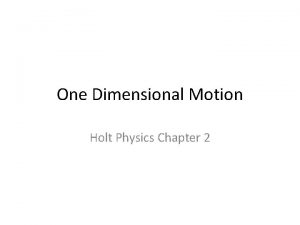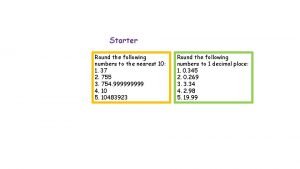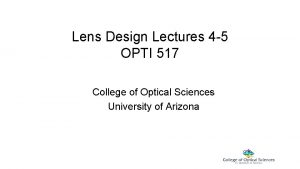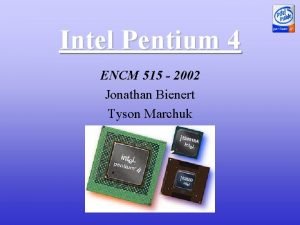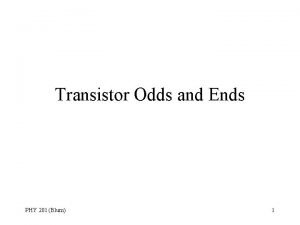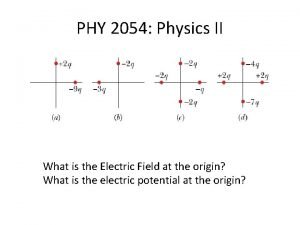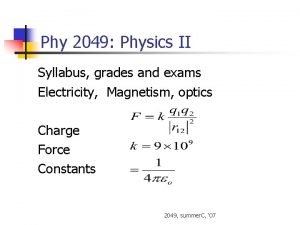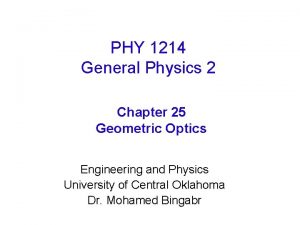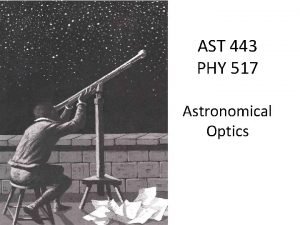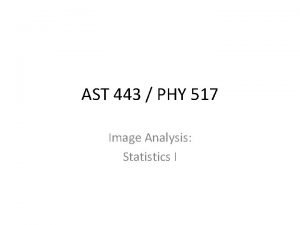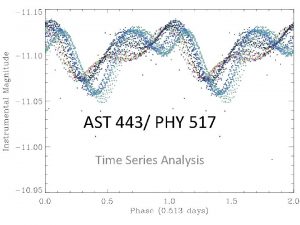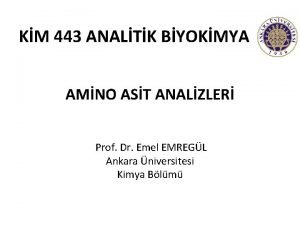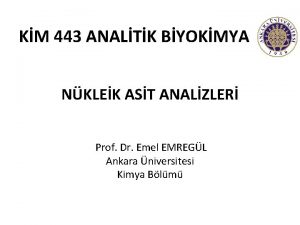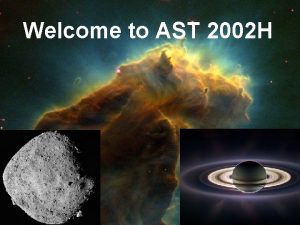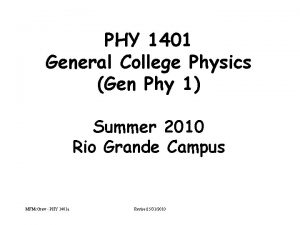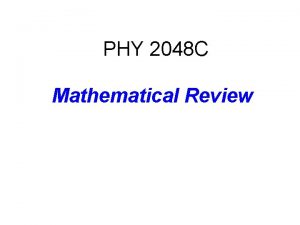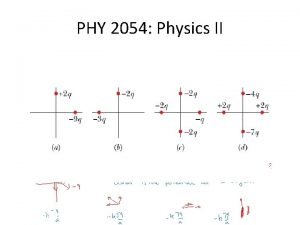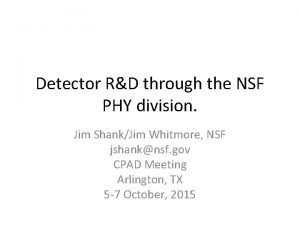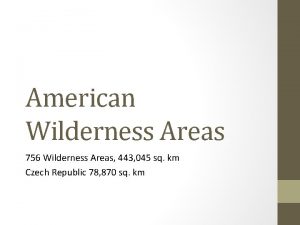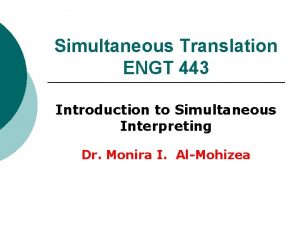AST 443 PHY 517 Astrometry Astrometry Your detector




![Tangent Plane Geometry RA, DEC to X, Y: • X = - [cos(δ) sin(z)] Tangent Plane Geometry RA, DEC to X, Y: • X = - [cos(δ) sin(z)]](https://slidetodoc.com/presentation_image_h2/63dfe43e27a927d1b171f799cf05c11c/image-5.jpg)























- Slides: 28

AST 443/ PHY 517 Astrometry

Astrometry • Your detector records events at positions X, Y (detector coordinates) • You need to transform this to sky coordinates (α, δ or equivalent) on the sky • Your detector is (probably) flat • The focal plane is (usually) curved • Everything moves

Celestial Reference Points • The reference point is γ , the first point of Aries, at (α, δ ) = (0, 0) • γ is the ascending node of the ecliptic, where it crosses the celestial equator. • The celestial coordinate system is actually defined by a grid of extragalactic point radio sources. • The official reference is the International Celestial Reference System (ICRS). • The position of the celestial poles and the origin of right ascension are fixed to within 20 m” (micro-arcsec) with reference to this grid of quasars.

Converting X, Y to α, δ : Tangent Plane Geometry • The sky, a spherical surface, is curved • Images of the sky are flat • The measured X, Y positions on a flat image do not translate linearly into angular offsets on the sky • The math is straightforward
![Tangent Plane Geometry RA DEC to X Y X cosδ sinz Tangent Plane Geometry RA, DEC to X, Y: • X = - [cos(δ) sin(z)]](https://slidetodoc.com/presentation_image_h2/63dfe43e27a927d1b171f799cf05c11c/image-5.jpg)
Tangent Plane Geometry RA, DEC to X, Y: • X = - [cos(δ) sin(z)] / [sin(δ) sin(d) + cos(δ) cos(d) cos(z)] /S • Y = [sin(δ) cos(d) - cos(δ) sin(d) cos(z)]/[sin(δ) sin(d) + cos(δ) cos(d) cos(z)]/S – z=(a-a) • • • X, Y to RA/DEC: θ = tan(-X*S/Y*S) φ = tan(sqrt[(X*S)2+(Y*S)2]) δ = arcsin(d) cos(φ) + cos(d) sin(φ) cos(θ ) α = a + arcsin((sin(φ) sin(θ ) / (cos(d) cos(φ) - sin(d) sin(φ) cos(θ))) – a, d are the RA, DEC of the tangent point - the place where the image is tangent to the sky (generally the center of the image). – S is the plate scale (radians per mm, or equivalent).

Distortions • All telescope optics introduce distortions into the images. – Coma and astigmatism do not directly affect positions. – But they introduce systematic positional offsets unless the proper position-dependent point-spread-function is used. – Pincushion and barrel distortions directly affect positions. – Higher order aberrations introduce other distortions. • In practice, one maps these distortions using a dense grid of stars of known positions (e. g. , a globular cluster), and determining the empirical correction between X and Y on the plate and Δα, Δδ on the sky. • This correction is ususally carried to third order (i. e. , terms to xny 3 -n, including cross terms).


HST imagers: residual distortions after subtracting secondorder terms. (from the HST data handbook)

Everything Moves • The Earth (your observing platform) rotates (0. 5 km/s), and orbits the Sun (30 km/s) • The Sun orbits the Galaxy (220 km/s) • The Galaxy moves relative to the cosmic microwave background (600 km/s)

Earth-Induced shifts • Diurnal aberration: due to the Earth's rotation. In celestial coordinates: Δα =-k cos(φ) cos(h) sec(δ) Δδ = -k cos(φ) sin(h) sin(δ) – – • • • k=0. 3198" φ: geodetic latitude of the observer h: hour angle of the target δ: declination of the target Annual aberration: due to the Earth’s orbit. In ecliptic coordinates: Δλ = -k cos(λ - λ 0) sec(β) Δβ = -k cos(λ - λ 0) sin(β) – k = 20. 496 arcsec – λ 0: ecliptic longitude of the Sun Annual aberration is of order v⊕/c radians. It is a consequence of the finite speed of light. Over a year, the star traces an ellipse with semimajor axes k, k sin(β). At the ecliptic pole this reduces to a circle; on the ecliptic this is a line. Aberrations shift the entire field, and so do not generally affect the relative positions of objects. You need to account for these aberrations if you need to point the telescope with arcsecond accuracy. In extreme cases, differential stellar aberration across the field is a significant effect: Differential distortion due to the difference in stellar aberration across the HST/ACS field can amount to 0. 04" (0. 8~pixels)

Differential Refraction dα = -tan(α 0) dn • α 0: angle of incidence on plane parallel atmosphere (90 o-zenith distance) • With a large field of view, α 0 can vary enough that dα is measurably different across the field • LSST will have a 3. 5 o Fo. V – At zd=45 o, dα(46. 5 o)-dα(43. 5 o) = 6. 2”

Proper Motion • The peculiar motion of an object relative to some local standard, either the heliocenter or the local standard of rest (LSR). • The proper motion μ = v/D – v is the peculiar velocity of the object – D is its distance. • Units are usually expressed in arcsec/year. • Solar peculiar velocity: 19. 5 km/s towards 18. 0 h, 30 o. • Correction for the Solar peculiar velocity is called reduction to the local standard of rest.

Proper Motion: Nearby neutron star

RX J 1856 -3754: 2 years of proper motion HST ACS/HRC Pixel size: 0. 027” Wobble due to parallax

Annual Parallax • Annual Parallax π: due to the orbit of the earth around the Sun. – At a distance of 1 parsec, π = 1 arcsec. – The motion is a circle at the ecliptic poles and a line on the ecliptic. – The shape of the ellipse is completely defined by the target’s coordinates, only the scaling (π) is a free parameter – Distance in parsecs = 1/π

Diurnal Parallax Diurnal parallax: the difference in zenith distance seen by the observer (on the Earth's surface) and the zenith distance seen from the geocenter. • The maximum diurnal parallax is (r/d) cos l – r: radius of the Earth – d: distance to the object in Earth radii – l: observer's latitude. • The maximum diurnal parallaxes of the Moon: 57' ; Sun: 8. 8"

Motion with PM subtracted

Parallactic Ellipse

Probability Parallax probability distribution π (mas)

What can you measure? • You can easily centroid to ~ 1/10 the PSF. – At Mt Stony Brook: ~0. 1” (1/π=10 pc) – With CTIO 1. 3 m/Andicam: ~. 04” (1/π=25 pc) – With HST/ACS: ~0. 005” (1/π=200 pc) – With GAIA: 24 m” positions (8 kpc at 5 s) • Proper motion is cumulative. Be patient.

Source: Pancino 2002, ASR 65, 1

How do you measure? • Differentially. • Use lots of reference stars. – Uncertainties ~ 1/√n • Solve for the plate scale • Parallax + Proper motions: – 3 free parameters (π, μ α , μ δ ) – Need >3 observations – the more, the better – Best to observe at extrema of the parallactic ellipse

Cookbook • Correct for plate distortions – xobs⇒ xtrue – yobs⇒ ytrue • It is often easier to work in x, y rather than α, δ • xi=x 0 + μ x ti + Πx(Do. Yi)π • yi=y 0 + μ y ti + Πy(Do. Yi)π – Π is the parallactic offset for the day of year at 1 pc – Π is cyclic – Do. Y is the day of year (ti modulo 365) • Convert μ x, μ y to μ α , μ δ

Space Velocity • Proper Motion μ is ⊥ to the line of sight – Transverse velocity v. T = μ/π (arcsec /pc /yr) – v. T = 4. 78 μ(“/yr) d(pc) km/sec • Radial velocity RV is along the line of sight • Space velocity v=sqrt(v. T 2 + RV 2) • UVW: 3 D velocities wrt. the Galaxy (right handed) – – – U: velocity towards Galactic Center V: velocity in plane relative to circular orbit W: velocity towards NGP Solar UVW= [-9, 12, 7] See Johnsom & Soderbolom 1987, AJ 93, 864

Astrometry of Clusters Cr. A SFR from GAIA

Astrometry of Clusters Cr. A SFR from GAIA

Precession • The Vernal equinox undergoes a retrograde motion on a 25725 year cycle (the Platonic year). Ecliptic longitudes increase monotonically. • Lunisolar precession, due to the Moon and Sun: – P 0 = 50. 3878" + 0. 000049" T (T is the number of tropical years since 1900). • Planetary precession: P 1 = -0. 1055" + 0. 000189" T • General precession: P = P 0 + P 1 cos (ε ) = 50. 2910" + 0. 000222" T The change in α, δ: Pα = m + n sin(α) tan(δ) Pδ = n cos(α) m = 46. 124" + 0. 000279" t, n = 20. 043" - 0. 000085" t • Consequences of precession: – in 2115 CE, Polaris will be 28' from the NCP. – In 12, 000 years, Vega will be within 1 degree of the NCP. • Nutation refers to small changes in the rate of precession. – The NCP traces a 9. 2" ellipse on an 18. 6 year period because of the inclination of the lunar orbit to the Earth's equator.

Some Astrometric Catalogs • FK 5: the Fifth Fundamental Catalog of 1535 stars. • The USNO B 1. 0 catalog: – Positions, magnitudes, and proper motions for > 109 objects • The Hipparcos catalog – Astrometry and photometry of 118218 stars to 9 th magnitude. – Milli-arcsec precision. • Gaia: followup to Hipparcos; will operate through 2024 – positions to 10 m”; PMs of 2 x 109 objects to V~20. 5
 Experiment 443
Experiment 443 Din en 443 feuerwehrhelme
Din en 443 feuerwehrhelme Bungkas tree
Bungkas tree How to round to the nearest metre
How to round to the nearest metre 574-173-443
574-173-443 Opti 517
Opti 517 517 rounded to the nearest ten
517 rounded to the nearest ten 517 bc
517 bc 517 ad
517 ad Rd 517/2014
Rd 517/2014 Encm 515
Encm 515 Phy 131 past papers
Phy 131 past papers Phy 231 msu
Phy 231 msu The great orthogonality theorem
The great orthogonality theorem Phy 221 msu
Phy 221 msu Phy theorem
Phy theorem Phy113
Phy113 Phy 131 asu
Phy 131 asu Ddr phy architecture
Ddr phy architecture Phy 205
Phy 205 Eye accommodation
Eye accommodation Phy 2049
Phy 2049 Phy
Phy Phy
Phy Phy
Phy Atm basics
Atm basics Phy
Phy Phy 2049
Phy 2049 Phy 1214
Phy 1214


